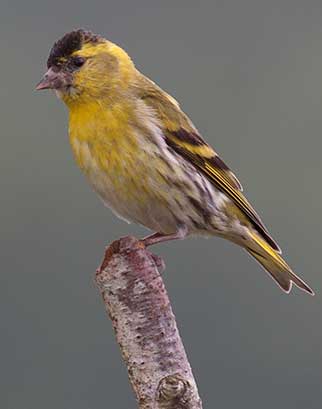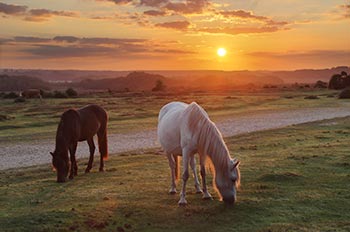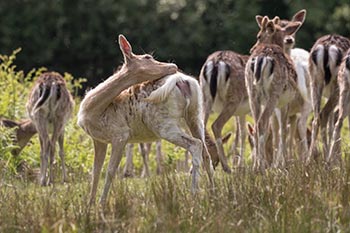Bird identification

siskin - greatly adds to the pleasure
of a walk in the countryside
An awareness of the identity and lifestyle of the birds and other wildlife encountered during walks in the New Forest will greatly enhance the experience. Indeed, a little knowledge and a degree of understanding will transform the walker from passer-by, to somebody who actually feels a part of life outdoors.
But where does the relative novice start with bird identification? Well, many people already have a surprising amount of knowledge, acquired from acquaintance with garden and suburban birds, and from wildlife television programmes. And adding to that is often not as daunting as might be imagined.
Here are a few tips that should help. Use them in conjunction with the pages relating to binoculars and field guides - both are essential items of basic equipment - and the section dealing with bird sound.
a) Become familiar with common, often seen birds. This helps develop identification skills, provides a basis for comparison, and helps in the process of elimination sometimes used when considering a new bird – it certainly wasn’t this, and it wasn’t that, so it was probably ……..
b) Try always to be alert - very little will be seen without a degree of concentration.
c) Develop the habit of being observant, and look out for key identification features on the birds you see.
d) Take notes for later reference – it’s often difficult to remember exact details, and seemingly minor points can make a big difference. Use a notebook to record the details, or a small digital or other recorder.
e) Pay particular attention to:
The size of the bird. Precise estimates may be difficult, particularly at a distance. Try then to compare what you see to more familiar birds – was it robin-size, blackbird-size, carrion crow-size, etc?
Plumage colours and patterns. What colour was the head, the wings, the body and tail? Was there an eye-stripe or wing-bars?
Behaviour. What was the bird doing? Was it perched low or high in a tree, or was hopping about on the ground?
Body shape. Was its body slender, dumpy or about average?Tail length and shape. Was it long or short, wide or narrow?
Wing shape. Were the wings short and rounded, or long and thin?
Bill. How long was the bill, what was its colour and shape? Was it long and thin, short and wedge-shaped, straight or down-curved?
Leg length and colour. How long were the legs, and what colour were they?
Stance and walk. Was the stance upright or horizontal, did the bird move quickly or slowly, did it hop or walk?
Flight pattern. Was this fast or slow, undulating, soaring, erratic, meandering or direct?
Was the bird alone, with a couple of others or in a flock?
What were the song and call characteristics?
f) Develop an awareness of what is likely to be seen in the habitat you’re visiting, and when. (For New Forest birds, The Hampshire Bird Report, published by Hampshire Ornithological Society, is an excellent source of information.
Use this knowledge as part of a process of elimination when trying to identify an unrecognised bird. A winter visitor to Britain, for example, is unlikely to be seen on a summer’s day. Equally, a common bird that fits the description of one seen is more likely to be encountered than a similar species that is hardly ever encountered in Hampshire. Be aware, though, that rarities do turn up when least expected, and so do birds that could be considered to be out-of-season.
g) Build up your skills by going out at times when birds are most likely to be seen:
In late-winter and spring, for many species, this means dawn. Birds are then at their most conspicuous as males sing and display whilst trying to establish and defend territories, and attract and retain a mate. Even the most enthusiastic, though, may struggle with 4.30 am starts in mid-May, but the closer to dawn you’re out, the better. 8.00 am, for example, is likely to be considerably more productive than 10.00 am, which in turn will be better than mid-day.
Song and other breeding season activities are repeated to a lesser extent at dusk, and this can also be a good time for the birdwatcher. It is, of course, also the best time to see and hear crepuscular and nocturnal birds – nightjars, owls and woodcocks, for example.
In autumn and winter, bird activity also often peaks at dawn as birds awake and start to feed, taking in much-needed resources after the cold nights. Feeding activity is also often conspicuous around mid-day – the bird’s lunch-time - and again in mid/late afternoon as food is sought before going to roost.
Some birds of prey, though, like the warm air of mid-day on which to soar, whilst away from the immediate vicinity of the New Forest, the behaviour of many coastal birds - redshanks, grey plovers and black-tailed godwits, for example - is determined by the state of the tide rather than the time of day.
h) To obtain good views, be as inconspicuous as you can, which means at least being quiet, wearing clothing of subdued colour and avoiding unnecessary hurried movements.
i) And finally, don’t be afraid to ask for advice from other birdwatchers. Most will be happy to help, and indeed, may welcome the opportunity of discussing identification issues. (Taking this a stage further, why not join a local society, and attend its field trips, for much good advice can be obtained on such occasions. Again, in Hampshire, the Hampshire Ornithological Society is a good choice).
Quick linksMore links
Other related links
Search this site

Sadly, 58 animals were killed - 35 ponies, 13 cows, 8 donkeys and 2 sheep, whilst a further 32 were injured - 3 pigs, 9 donkeys, 11 cows and 9 ponies.
(Forty-three accidents occurred in daylight, 15 at twilight and 101 in the dark. Twenty-seven accidents were not reported by the driver involved).
Here's just one horrific example - Three donkeys killed in collision with van at notorious New Forest blackspot (Advertiser and Times)


Sika deer continue to engage in rutting behaviour, and will do so until December.
Pigs seek out the remains of the acorn crop.
Beech leaves are transformed into a magnificent mosaic of glorious reds and golds. Other deciduous trees, too, take on an autumnal cloak before their leaves fall.
Dragonflies can occasionally be seen on the wing on bright days early in the month.
December
Foxglove leaves survive the winter at ground level, and offer the prospect of colourful summer blooms to come.
Redwings and fieldfares, autumn and winter visitors, gorge on haws and holly berries.
Great grey shrikes and hen harriers hunt over the heaths and other open spaces.
Honeysuckle by the end of the month often shows welcome signs of new growth.

